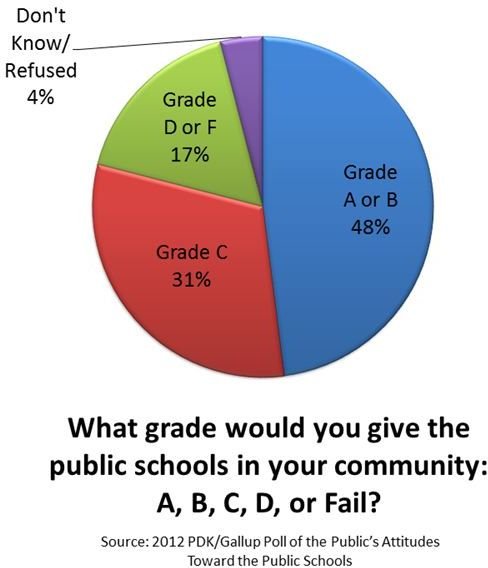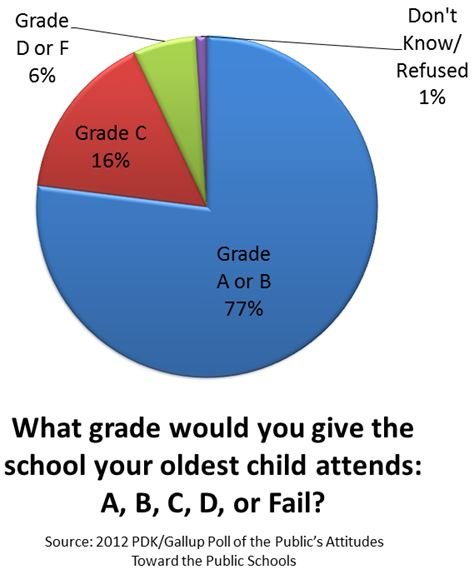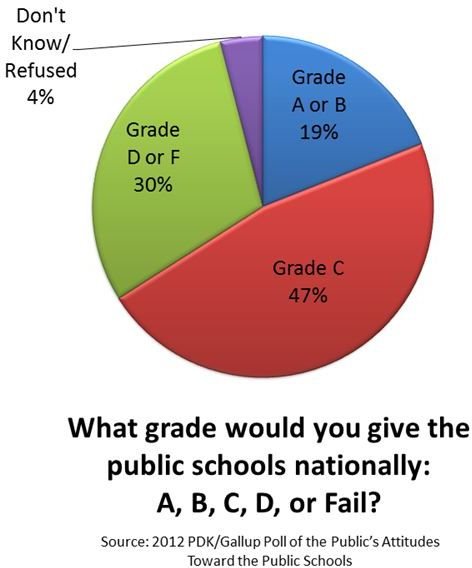America's Perceptions of the Nation's Public Schools: Are We More Pessimistic Than We Should Be?
What Do Americans Think About the Nation’s Public Schools?
The grass is always greener on the other side of the fence. Or is it? When it comes to our beliefs about how well our nation’s public schools are doing, the opposite seems to be true.
Every day, we’re hit with new stories that point out the failures of our public education system. People from all walks of life claim we’re suffering from a plague of bad teachers and call out for the need to impose more rigorous standards on educators – before they’re certified to teach and after they actually hit the classroom. Standards are being re-evaluated and replaced… with other standards. On one side of the street, the crowd is yelling that it’s a lack of funding which is holding our schools and students back. On the other side, there are protests that we’re already spending too much and not seeing any results.
Are our public schools really in that bad of shape?
In a recent Gallup Poll commissioned by Phi Delta Kappa International (PDK), when Americans were asked how they would grade the public schools in the nation as a whole, only 1% responded with an A rating. Although 47% of the poll takers did respond with a C rating, the combined total for A and B responses was only 19% while 30% gave the nation’s public schools a D or F.
Before reading on, stop for a moment and think about what grade you would have given our country’s public school system if you had taken part in the survey. Also, how would you grade just the schools in your community? Do you think your local schools should rank higher than the national average?
Our Impressions of Our Local Public Schools

In 2012 the PDK/Gallup poll mentioned above asked a couple of other questions about the grading of public schools. Here’s the first question of interest, in its entirety:
Students are often given the grades A, B, C, D, and Fail to denote the quality of their work. Suppose the public schools themselves in your community were graded in the same way. What grade would you give the public schools here — A, B, C, D, or Fail?
Since this was a nationwide poll, one might expect that the responses to this question would be similar to the ones above, but that’s not the case at all. The combined A and B responses jumped to 48%, and only 17% rated their local public schools with a D or F. This would seem to indicate that most Americans feel like the schools in their community are doing a fairly decent job.
But, there was one more question asked…
Our Impressions of Our Children’s Schools

The last question of this sequence was only for parents and asked them to grade the school attended by their oldest child. A whopping 77% responded with either A or B, and only 6% gave a D rating – that’s right, there were no failing grades in this category.
So, let’s think about what this all means here. If we take these results at face value, most Americans seem to think that the public school system isn’t doing that great a job on the national level, but the schools in their community are good. What about their kids’ schools? Well, they’re practically awesome! How does this make sense? How can there be a problem on the national level if things are fine at every local level? It’s important to note that this apparent contradiction isn’t unique to the 2012 poll. Similar responses have been given on other yearly polls, at least as far back as 1992.
Now, let’s look at the pie charts for these three questions side by side. Notice how the blue segment representing the combined A and B responses keeps growing as the questions start addressing schools that are closer to home?
Update: In 2012, this same PDK/Gallup Poll was repeated and the number of parents approving of the schools in their community improved from 47 to 58 percent.
Are we overestimating how well the schools in our community are performing? Is it harder to honestly evaluate our local schools because we feel more connected to them and we’re more prone to give them the benefit of the doubt? Or, are we _under_estimating how well our nation’s schools are performing as a whole? If the latter is the case, why?
Maybe it’s time to refresh our perceptions and try to start with a clean slate. I know – that’s a lot harder than it sounds. But, if we can find a way to drop our old preconceptions and still accept that there is always room for improvement, we can focus more on how we can help our schools become better instead of pointing accusatory fingers off into the distance.
References
- Phi Delta Kappa. “PDK/Gallup Poll of the Public’s Attitudes Toward the Public Schools.” http://www.pdkintl.org/poll/index.htm
